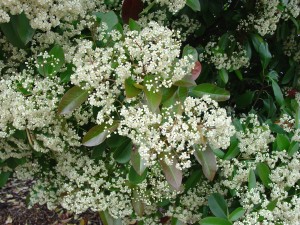Some 30-40 years ago redtip photinia (Photinia x fraseri) was commonly planted as a broadleaf evergreen hedge in the Southeast U.S. (USDA hardiness zones 6 -8). This dense growing 15 foot tall and wide shrub sports firey red new leaves in spring and summer. The red leaf tint fades to green within a few weeks.
Many homeowners desire a fast growing evergreen shrub when planting a hedge or screen between their neighbors and redtip photinia delivers. Its white flowers were not foul-smelling as other photinia species.
Photinias are great plants in many areas of the U.S., but not in the humid Northeast and Southeastern U.S. Redtip photinia is highly susceptible to Entomosporium leaf spot, a fungal disease. An almost weekly preventative spray program to protect the plant foliage all season long becomes costly and impractical.
Not all photinias are disease prone. Chinese photinia (P. serrulata) is leaf spot resistant. It grows taller at 20 feet in height and width, but lacks the red foliage color. Its flowers emit a foul odor in late March/early April. Japanese photinia (P. glabra) is similar in shrub size and shape to redtip. Its spring foliage color is bright red and blooms almost two weeks later in mid-April. However, Japanese photinia is susceptible to leaf spot.
Photinias handle average well-drained soils in full or partial sunlight. Planted in heavy shade, foliage density is less and more prone to disease. Overhead watering in dry summer periods results in higher disease outbreaks. Hedge or prune photinias in late winter or late summer when not actively growing.
Some alternative broadleaf evergreen shrubs include hollies (Ilex), cherry laurels (Prunus), gold dust shrubs (Aucuba), euonymus, mahonias, and nandinas.


 Posted in
Posted in 
